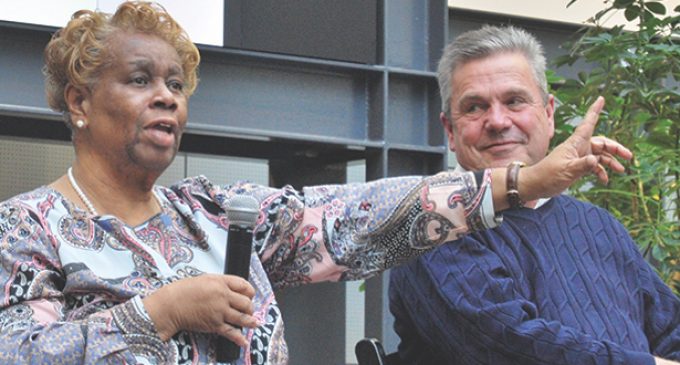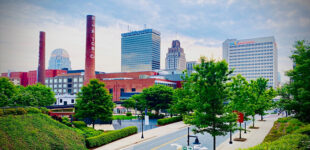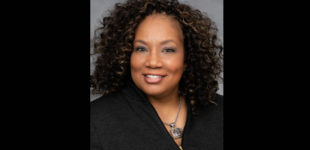Panelists recall life for black people in tobacco district neighborhoods

Photos by Todd Luck Barbara Morris talks about growing up in the Belews Street neighborhood as Jack Steelman looks on.
By Todd Luck
The Chronicle
Panelists at the “Remembering the Neighborhood” event recalled when Patterson Avenue was a thriving part of the black community with a YMCA branch and many businesses on it. They also recalled what life was like in the surrounding black neighborhoods of the former Winston-Salem tobacco district.
“Reynoldstown was a very special place for all of us,” said Annette Scippio. “When we grew up there we didn’t know how really special it was because we just thought it was home.”
They spoke last Saturday at the Wake Forest Biotech Place, the former tobacco warehouse on North Patterson Avenue. Biotech Place is now filled with research labs in the Wake Forest Innovation Quarter.
The panel consisted of Scippio, former executive director of Leadership Winston-Salem and a community historian; Jack Steelman, former city economic development officer who was involved in the development of downtown; Barbara Morris, a former resident of the Belews Street community; Rudy Anderson, director of internal communication at Winston-Salem State University and Miles Harry, who worked for RJ Reynolds for a summer in his youth and now owns Miles Computer Services.
They had many memories of the old days. Scippio is from Reynoldstown, a neighborhood originally created for RJ Reynolds tobacco workers, where many prominent local African-Americans once resided.
Panelists recalled walking to different parts of the black community as youth, under the watchful eyes of their neighbors, and the great education they received at the “Big Four” black high schools.
Harry said that African-Americans in the city didn’t have to ride in the back of the bus during segregation.
“The black people in Winston-Salem never experienced that because we had Safe Bus,” he said, talking about the black-owned bus company that served the black parts of town.
Scippio said that though there were good things from that era, that segregation was still horrible. She recalled her mother holding her hand tight and telling to keep looking down when they would go to a white part of town.
Redevelopment that caused black neighborhoods to change or disappear was also discussed. Steelman said the building of Business 40 took its toll on the community.
“Even though the hearts of the community was still there, the fabric of the community was damaged, and it’s still that way today,” he said.
The Federal Aid Highway Act of 1956, which provided funds for highway construction, led to the demolition in many states of what were considered declining neighborhoods. Locally, the neighborhood of Belews Street was demolished to make way for U.S. 52 and Business 40.
Scippio said urban renewal, which was a national effort to remove substandard housing in blighted neighborhoods, was devastating to the black community, as nice houses were destroyed along with the good ones.
“East Winston was completely demolished,” said Scippio.
She said homeowners, who only got the tax value of the home, had to start over again.
Anderson said his father often remarked that integration was “the worst thing that ever happened to us.” Anderson said that African-Americans, in trying to assimilate into larger society, lost its sense of self. With the black community no longer restricted to goods and services on the black side of town, many black businesses would eventually disappear.
Also during the event, the New Winston Museum collected memories on maps of the area. Oral stories of former R.J. Reynolds workers were collected by UNC-Greensboro Museum Studies Masters student Amanda Holland.
The city’s Centennial exhibit was also on display (The city was 100 years old in 2013.), and tables were set up by Old Salem’s St. Philips Heritage Center, the Society for the Study of Afro-American History in Winston-Salem, City and County Planning Department (which is over historic markers) and the office of City Council Member Derwin Montgomery.











